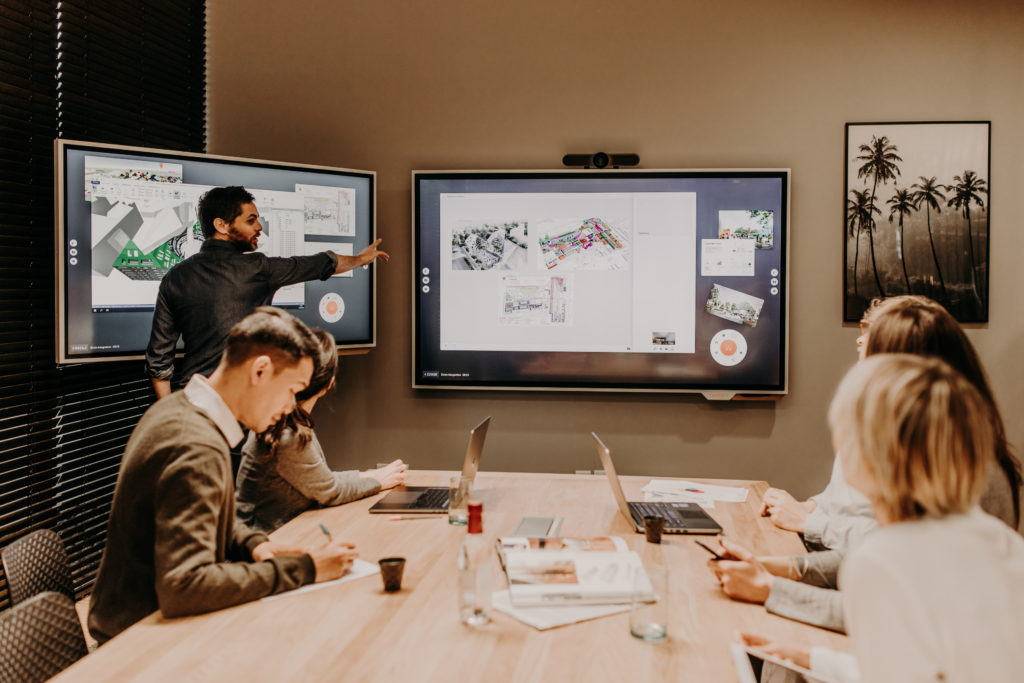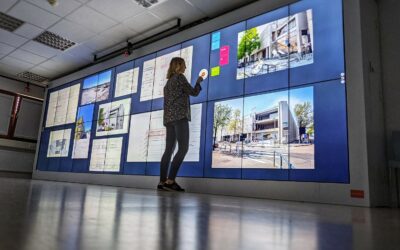The hybridisation of work is underway, oscillating between face-to-face and remote work. Companies as well as employees must adapt to maintain efficiency, productivity, and commitment. If our working methods are evolving it is also necessary to change our tools and the configuration of our workspaces. What do employees seek during a post-Covid era? What is the role of companies? Is hybrid work the new Eldorado? How can we design workspaces that enable successful hybrid collaboration? Read our article for some answers.

1. State of play after the pandemic
“Health crisis has changed the way we work” is probably the most written – and boring – sentence over the last 18 months when it comes to new ways of working. Obviously, the transformation would probably have been smoother and the realisations more measured. But what does the next world really look like? Several studies have looked into the matter.
- Before the crisis, teleworking was only practiced by 34% of companies with 50 or more employees, compared to 91% today.1
- After the crisis, 78% of French employees aspire to a hybrid work model that would allow them to mix office and teleworking and this rate rises to 64% worldwide.2
- 40% of employees believe that working hours should be flexible.3
- 79% of managers consider to let their employees share their time between the company and another workplace, at home or in a coworking space, if their position allows it.4
- 86% of French employees will now have more choice and control over where they work. In this new world, well-designed workspaces can give companies a key competitive advantage.5
- But 58% of employees miss face-to-face collaboration.6

2. When employee aspirations meet company strategy
When it comes to work organization: teleworking has to be considered. It is not easy to solve the equation: full-remote, occasional or standard teleworking. Telecommuting is a game changer. The new Eldorado seems to be hybrid work, a clever mix of face-to-face and remote work that would delight both employees and companies.
On-site or face-to-face work makes it possible to keep the link. It should stimulate social interaction. We enjoy days at the office to share some time with our colleagues over a coffee or a lunch.
Teleworking, on the other hand, allows the conciliation of professional and personal life. Working from home allows a better concentration and productivity. For example, 51% of those under 30 years old say they are more productive since the introduction of working from home7. Interruptions every 12 minutes8 are gone and individual productivity has increased by 13%9. Fatigue, stress and time spent in transport are gone too. This time saved can be used by happy teleworkers for sports, shopping, napping or picking up their kids from school. Be sure to set limits and take healthy breaks.
Employees want to be able to work from anywhere, but also need more face-to-face interaction. We called that “hybrid paradox”10, which is essential for a successful transition to hybrid working.
When employees get the flexibility they want, they are more comfortable with the unexpected circumstances and their companies benefit from increased productivity, engagement, and loyalty.11 Thus, getting the best of both worlds is a common aspiration of employees and organisations.

3. Beyond hybrid work: hybrid collaboration
Now that employees are everywhere: at home, at a coworking space, away from home, on site: how can we help them to work together? Better: how can they collaborate?
The health crisis has forced companies to come up with new ways of collaborating to create a physical experience for the employee. How can they do this? By fully embracing collaboration technologies, but not in any way or at any cost.
Until now, many companies – especially large corporations – have been looking at Unified Communications and Collaboration (UCC). UCC is “the ability to exchange and share information without a sender or receiver being subject to any location, content, time, media, number or availability of actors”.12
The era of the employee experience has come. We are witnessing changes in employee requirements in terms of premises, networks, and business processes. The younger generation is enthusiast about new technologies and does not struggle to use them. 32% of them indicate that it is one of the essential criteria for their integration into a new company.13
Companies can then draw inspiration from those who had already gone full-remote before the crisis. They advocate a written culture to track exchanges and ensure that information and decisions are shared by all. The use of synchronous and asynchronous communication tools also gives employees greater flexibility.
Companies must therefore imagine and propose – with the support of expert partners – effective solutions to make hybrid collaboration easier and more attractive to their employees. One of these solutions lies in the workspaces themselves, as employees are increasingly demanding about their working environment.14

4. Well-designed workspaces are key to success
We already know that a foosball or unlimited smoothies are not enough to make employees happy. As a result: 42% of employees do not feel “energised” at work15. Imagining and designing spaces for collaboration, socialization, innovation, and motivation in the workplace is a key success factor for successful hybrid collaboration.
As we saw earlier, employees are looking for social interaction during their face-to-face days. Thus, work that requires a collective approach: brainstorming, project launch,… should take place in carefully designed workspaces. Fewer offices and more collaborative spaces optimally designed and equipped to promote the employee experience. Collaboration spaces where you feel good and where technology is present but not the attraction.
Can’t get all your staff together in the same space? Welcome to the next world. Your workspace should be able to connect these remote people as well. Be careful to choose a solution that does not make them spectators. They deserve to live the same experience where they will be able to benefit from all the information and even the emotions to fully participate in this meeting. Thus, a fruitful hybrid collaboration between colleagues, departments, sites and external stakeholders will be created. These new spaces will have to combine both employees expectations and companies needs.
What about serendipity? This is one of the potential flaws of teleworking: how can you innovate when everyone is at home or when your day in the office is like a marathon of meetings? Here again: workspaces have a role to play. It’s not just a matter of adding a big screen and some footstools to your meeting room to make it a great collaboration place. You also need to rethink your break room, your kitchen, your lobby and even your corridors. Bring in an expert to help you unlock the potential of your space to foster collaboration and innovation.
And don’t overlook the attractiveness of hybrid collaboration workspaces for your current and future talents. In certain professions where the labour market is under pressure, successful hybrid collaboration and workspaces that encourage socialization, relaxation, meetings, and innovation are a real weapon for massive recruitment and talent retention.

Do you want to go further in the search for successful hybrid collaboration? We imagine and design workspaces that look like you to bring out the full potential of your employees. Contact us to discuss your project and bring it to life.
1 OpinionWay survey for Microsoft France – 2021
2 BCG survey for Cadremploi
3 Sharp survey
4 WeWork survey
5 Steelcase survey
6 JLL Barometer
7 Sharp survey
8 Apec survey – december 2020
9 Malakoff Humanis Telework Barometer 2021
10 Microsoft
11 WeWork survey
12 Definition of CIGREF
13 Sharp survey
14 Sharp survey
15 JLL Barometer


